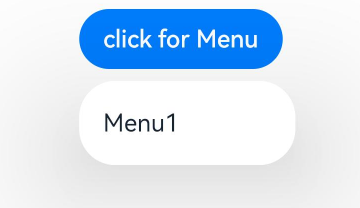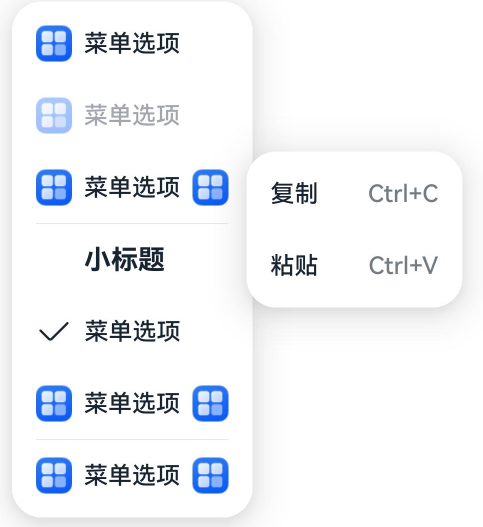harmony 鸿蒙菜单控制(Menu)
菜单控制(Menu)
Menu是菜单接口,一般用于鼠标右键弹窗、点击弹窗等。具体用法请参考菜单控制。
使用bindContextMenu并设置预览图,菜单弹出时有蒙层,此时为模态。
使用bindMenu或bindContextMenu未设置预览图时,菜单弹出无蒙层,此时为非模态。
生命周期
| 名称 | 类型 | 说明 |
|---|---|---|
| aboutToAppear | () => void | 菜单显示动效前的事件回调。 |
| onAppear | () => void | 菜单弹出时的事件回调。 |
| aboutToDisappear | () => void | 菜单退出动效前的事件回调。 |
| onDisappear | () => void | 菜单消失时的事件回调。 |
创建默认样式的菜单
菜单需要调用bindMenu接口来实现。bindMenu响应绑定组件的点击事件,绑定组件后手势点击对应组件后即可弹出。
Button('click for Menu')
.bindMenu([
{
value: 'Menu1',
action: () => {
console.info('handle Menu1 select');
}
}
])

创建自定义样式的菜单
当默认样式不满足开发需求时,可使用@Builder自定义菜单内容,通过bindMenu接口进行菜单的自定义。
使用@Builder自定义菜单内容
class Tmp {
iconStr2: ResourceStr = $r("app.media.view_list_filled");
set(val: Resource) {
this.iconStr2 = val;
}
}
@Entry
@Component
struct menuExample {
@State select: boolean = true;
private iconStr: ResourceStr = $r("app.media.view_list_filled");
private iconStr2: ResourceStr = $r("app.media.view_list_filled");
@Builder
SubMenu() {
Menu() {
MenuItem({ content: "复制", labelInfo: "Ctrl+C" })
MenuItem({ content: "粘贴", labelInfo: "Ctrl+V" })
}
}
@Builder
MyMenu() {
Menu() {
MenuItem({ startIcon: $r("app.media.icon"), content: "菜单选项" })
MenuItem({ startIcon: $r("app.media.icon"), content: "菜单选项" }).enabled(false)
MenuItem({
startIcon: this.iconStr,
content: "菜单选项",
endIcon: $r("app.media.arrow_right_filled"),
// 当builder参数进行配置时,表示与menuItem项绑定了子菜单。鼠标hover在该菜单项时,会显示子菜单。
builder: this.SubMenu
})
MenuItemGroup({ header: '小标题' }) {
MenuItem({ content: "菜单选项" })
.selectIcon(true)
.selected(this.select)
.onChange((selected) => {
console.info("menuItem select" + selected);
let Str: Tmp = new Tmp();
Str.set($r("app.media.icon"));
})
MenuItem({
startIcon: $r("app.media.view_list_filled"),
content: "菜单选项",
endIcon: $r("app.media.arrow_right_filled"),
builder: this.SubMenu
})
}
MenuItem({
startIcon: this.iconStr2,
content: "菜单选项",
endIcon: $r("app.media.arrow_right_filled")
})
}
}
build() {
// ...
}
}
使用bindMenu属性绑定组件
Button('click for Menu')
.bindMenu(this.MyMenu)

创建支持右键或长按的菜单
通过bindContextMenu接口自定义菜单,设置菜单弹出的触发方式,触发方式为右键或长按。使用bindContextMenu弹出的菜单项是在独立子窗口内的,可显示在应用窗口外部。
- 使用@Builder自定义菜单内容,与上文写法相同。
- 确认菜单的弹出方式,并使用bindContextMenu属性绑定组件。示例中为右键弹出菜单。
Button('click for Menu')
.bindContextMenu(this.MyMenu, ResponseType.RightClick)
菜单弹出时振动效果
菜单从API version 18开始支持振动效果。菜单弹出时,默认不振动。若希望菜单弹出时有振动效果,可以通过ContextMenuOptions的hapticFeedbackMode属性,设置菜单弹出时的振动模式。
- 只有一级菜单可配置弹出时振动效果。
- 仅当应用具备ohos.permission.VIBRATE权限,且用户启用了触感反馈时才会生效。开启触控反馈时,需要在工程的module.json5中配置声明权限的requestPermissions字段开启振动权限,配置如下:
"requestPermissions": [
{
"name": "ohos.permission.VIBRATE",
}
]
Button('click for Menu')
.bindContextMenu(this.MyMenu, ResponseType.RightClick, { hapticFeedbackMode: HapticFeedbackMode.ENABLED })
你可能感兴趣的鸿蒙文章
0
赞
- 所属分类: 后端技术
- 本文标签:
热门推荐
-
2、 - 优质文章
-
3、 gate.io
-
7、 openharmony
-
9、 golang